
Polyacrylamide (PAM) is a high-molecular-weight polymer known for its excellent solubility and functions as a flocculant, coagulant, and thickener. It is widely applied in water treatment, oil and gas, papermaking, mining, and agriculture, primarily to enhance solid-liquid separation and improve sedimentation efficiency.
√ Anionic PAM (APAM): Ideal for wastewater treatment, sludge dewatering, and processes involving negatively charged particles.
√ Cationic PAM (CPAM): Commonly used in municipal wastewater, sludge conditioning, and dewatering.
√ Non-Ionic PAM (NPAM): Suitable for neutral pH water treatment and organic matter removal.
What is the cationic degree in cationic polyacrylamide?
Water Treatment – Used in municipal plants, drinking water purification, and industrial effluents.
Oil & Gas Industry – Applied in enhanced oil recovery (EOR), drilling fluids, and hydraulic fracturing.
Papermaking – Improves retention, drainage, and paper strength.
Mining & Mineral Processing – Facilitates tailings treatment and slurry dewatering.
Agriculture – Improves soil water retention and structure, particularly in arid regions.
How to choose PAM according to the factory
The global PAM market is expected to grow at a CAGR of 6%+ in the next five years, especially in China, India, and Southeast Asia.
√ Rising Water Treatment Demand – Driven by urbanization and stricter wastewater regulations.
√ Oil & Gas Expansion – Energy needs push PAM demand in EOR and drilling.
√ Sustainability Initiatives – Development of eco-friendly and biodegradable PAM derivatives.
Q1: What is the optimal dosage of PAM?
A1: Dosage depends on water quality and treatment goals; typically ranges from 1–10 ppm.
Q2: Is PAM safe?
A2: Industrial-grade PAM should be handled carefully, while drinking-water grade PAM complies with international safety standards.
Q3: Can PAM be used with other treatment chemicals?
A3: Yes, PAM is often used with inorganic coagulants like PAC, aluminum sulfate, and ferric salts for better efficiency.
Q4: What’s the difference between APAM and CPAM?
A4: APAM is suited for wastewater with positively charged or neutral particles, while CPAM is better for negatively charged sludge and municipal sewage.
Q5: What is the market outlook for PAM?
A5: Strong growth in Asia-Pacific, driven by water treatment demand and oil exploration, makes it one of the fastest-growing chemical markets.
Common problems and solutions of polyacrylamide
How to use PAM and precautions
Application and Challenges of PAM in the Oil Production Industry

Please contact us for free quotation by form below. We promise the quickest response within 24 hours: